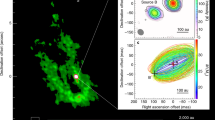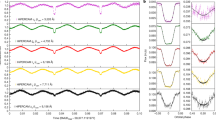Abstract
We present the results of a 3.5 year long campaign to measure orbital periods of subdwarf-B (sdB) star binaries. We directly compare our observed orbital period distribution with that predicted by using binary population synthesis. Up to now, most of our systems seem to have been formed through two of the formation channels discussed by Han et al. (2003, MNRAS 341, p. 669), i.e. the first and the second common envelope ejection (CE) channels. At this point, thanks to the long baseline of our observations, we are starting to detect also very long orbital period systems. These have probably come from a complete different formation path, the first stable Roche Lobe overflow (RLOF) channel in which the first mass transfer phase is stable. This channel is expected to lead to the formation of very wide binaries with typical orbital periods ranging from 1 month to 1 year.
Similar content being viewed by others
References
Cumming, A., Marcy, G.W. and Butler, R.P.: 1999,ApJ 526, 890.
Edelmann, H., Heber, U., Lisker,T. and Green, E.M.: 2004, in: P.F.L. Maxted (ed.), Extreme Horizontal Branch Stars and Related Objects, Ap&SS 291, 315.
Green, E.M., Liebert, J. and Saffer, R.A.: 2001, ASP Conf. Ser., vol. 226, XII European Workshop on WDs.
Han, Z., Podsiadlowski, Ph., Maxted, P.F.L, Marsh, T.R., and Ivanova, N.: 2002, MNRAS 336, 449.
Han, Z., Podsiadlowski, Ph., Maxted, P.F.L, Marsh, T.R., and Ivanova, N.: 2003, MNRAS 341, 669.
Heber, U., Reid, I.N. and Werner, K.: 2000, A&A 363, 198.
Marsh, T.R., Dhillon, V.S. and Duck, S.R.: 1995, MNRAS 275, 828.
Maxted, P.F.L., Heber, U., Marsh, T.R., and North, R.C.: 2001, MNRAS 326, 139.
Maxted, P.F.L., Marsh, T.R., Heber, U., Morales-Rueda, L., North, R.C. and Lawson, W.A.: 2002, MNRAS 333, 231.
Maxted, P.F.L., Morales-Rueda, L. and Marsh, T.R.: 2004, in: P.F.L. Maxted (ed.), Extreme Horizontal Branch Stars and Related Objects, Ap&SS 291, 307.
Morales-Rueda, L., Maxted, P.F.L., Marsh, T.R., North, R.C. and Heber, U.: 2003, MNRAS 338, 752.
Napiwotzki, R.: 1997,A&A 322, 256.
Saffer, R.A., Bergeron, P., Koester, D. and Liebert, J.: 1994,ApJ 432, 351.
Tutukov, A. and Yungelson, L.: 1990, SvA 34, 57.
Author information
Authors and Affiliations
Rights and permissions
About this article
Cite this article
Morales-Rueda, L., Maxted, P.F. & Marsh, T.R. The orbital period distribution of subdwarf-B binaries. Astrophys Space Sci 291, 299–306 (2004). https://doi.org/10.1023/B:ASTR.0000044336.18366.39
Issue Date:
DOI: https://doi.org/10.1023/B:ASTR.0000044336.18366.39




